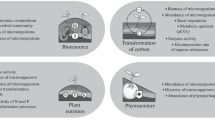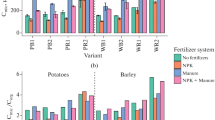Abstract
A method for estimating the nitrogen-fixing capacity of a population of rhizobia resident in soil is presented. legume test plants, growing under microbiologically-controlled conditions in test tubes packed with a vermiculite substrate moistened with a nitrogen-free plant nutrient solution, are inoculated directly with a suspension of the soil under examination. Rhizobia in the soil nodulate the test plants, and the amount of foliage dry matter produced in the 28 days after inoculation is regarded as an index of their effectiveness. An inoculum of at least 30, and preferably 100, rhizobia is needed to ensure that nitrogen fixation is not masked by delayed nodulation. The new method is tentatively described as the ‘whole-soil inoculation’ technique.
Appraisals were made withTrifolium subterraneum L. andRhizobium trifolii and withMedicago sativa L. andR. meliloti. Soil-borne pathogens did not interfere with plant growth. The whole-soil inoculation technique was less tedious and time-consuming than an alternative method which involved extracting representative isolates from the soil and testing their effectiveness individually, and appeared to give more realistic values for the nitrogen-fixing capacity of the soil as a whole. Used in association with a field experiment, the whole-soil inoculation technique confirmed microbiologically that there had been an agronomic response to surface application of inoculant to poorly-nodulatedT. subterraneum pasture.
It is submitted that this technique for determining the effectiveness of rhizobia in soil, combined with a plant-infection method for counting rhizobia, can be a reliable guide to the need for inoculation in the field.
Similar content being viewed by others
References
American Public Health Association 1955 Standard Methods for the Examination of Water, Sewage, and Industrial Wastes, 10th ed., Amer. Public Health Assoc., New York.
Andrew W D and Hely F W 1960 Frequency of annual species of Medicago on the major soil groups of the Macquarie region of New South Wales. Aust. J. Agric. Res. 5, 705–714.
Atkin-Smith R E, Gault R R and Brockwell J 1986 Effective rhizobia can be introduced, by surface application, into poorly-nodulated subterranean clover pasture. Proc. 8th Aust. Nitrogen Fixation Conf., AIAS Occ. Publ. No. 25, Eds. W Wallace and S E Smith, pp 151–152. Aust. Inst. Agric. Sci., Sydney.
Atkin-Smith R E, O'Brien G, Gault R R and Brockwell J 1988 Introduction of effective rhizobia into established subterranean clover pasture. Aust. J. Exp. Agric. 29 (In press).
Bell F and Nutman P S 1971 Experiments on nitrogen fixation by nodulated lucerne. Plant and Soil, special vol 231–264.
Bonish P M 1979 Clover rhizobia in soils: assessment of effectiveness using the plant infection count method. N. Z. J. Agric. Res. 22, 89–93.
Brockwell J 1963 Accuracy of a plant-infection technique for counting populations ofRhizobium trifolii. Appl. Microbiol. 11, 377–383.
Brockwell J 1971 An appraisal of an IBP experiment on nitrogen fixation by nodulated legumes. Plant and Soil, special vol., 265–272.
Brockwell J 1971 Selection ofRhizobium meliloti strains for inoculation ofMedicago rugosa Desr. cv Paragosa. CSIRO (Aust.) Div. Plant Ind. Fld Stn Rec. 10, 51–58.
Brockwell J 1980 Experiments with crop and pasture legumes — principles and practice.In Methods for Evaluating Biological Nitrogen Fixation. Ed F J Bergersen, pp 417–488, Wiley, Chichester, U.K.
Brockwell J, Diatloff A, Grassia A and Robinson A C 1975 Use of wild soybean (Glycine ussuriensis Regel and Maack) as a test plant in dilution-nodulation frequency tests for countingRhizobium japonicum Soil Biol. Biochem. 7, 305–311.
Cannon J R, Corbett N H, Brockwell J, Gibson A and McIntyre G A 1967 Nodulation and growth ofTrifolium subterraneum L. cv. Mount Barker in agar culture. Aust. J. Biol. Sci. 20, 285–295.
Date R A 1977 Inoculation of tropical pasture legumes.In Exploiting the Legume-Rhizobium Symbiosis in Tropical Agriculture. Eds. J M Vincent, A S Whitney, J Bose, pp 293–311, Univ. Hawaii, Honolulu.
Downes R G and Sleeman J R 1955 The soils of the Macquarie region, New South Wales. CSIRO (Aust.) Soil Publ. No. 4.
Gibson A H 1963 Physical environment and symbiotic nitrogen fixation. 1. The effect of root temperature on recently nodulatedTrifolium subterraneum L. plants. Aust. J. Biol. Sci. 16, 28–42.
Gibson A H 1967 Carbon dioxide limitations of plant growth in tube culture, with special reference to legume-nodulation studies. Aust. J. Biol. Sci. 20, 837–842.
Gibson A H 1980 Methods for legumes in glasshouses and controlled environment cabinets.In Methods for Evaluating Biological Nitrogen Fixation, Ed. F J Bergersen, pp 139–184, Wiley, Chichester, U.K.
Hely F W 1959 Adjustable shading to modify glasshouse temperatures. J. Agric. Engng Res. 14, 133–138.
McKnight T 1949 Efficiency of isolates of Rhizobium in the cowpea group, with proposed additions to this group. Qld J. Agric. Sci. 6, 61–76.
Robinson A C 1968 The effect of anti-fungal antibiotics on the nodulation ofTrifolium subterraneum and the estimation ofRhizobium trifolii populations. J. Aust. Inst. Agric. Sci. 33, 207–209.
Robinson A C 1969 Host selection for effectiveRhizobium trifolii by red clover and subterranean clover in the field. Aust. J. Agric. Res. 20, 1053–1060.
Roughley R J and Brockwell J 1987 Grain legumes and soil micro-organisms. Grain Legumes 1987 Research and Production Sem., AIAS Occ. Publ. No. 28, Eds. D R de Kantzow and M G May, pp 66–69 Aust. Inst. Agric. Sci, Sydney.
Thompson J A and Vincent J M 1967 Methods of detection and estimation of rhizobia in soil. Plant and Soil 26, 72–84.
Vincent J M 1970 IBP Handbook No. 15. A Manual for the Practical Study of Root-Nodule Bacteria, Blackwell, Oxford.
Weaver R W and Frederick L R 1972 A new technique for most-probable-number counts of rhizobia. Plant and Soil 36, 219–222.
Author information
Authors and Affiliations
Rights and permissions
About this article
Cite this article
Brockwell, J., Holliday, R.A. & Pilka, A. Evaluation of the symbiotic nitrogen-fixing potential of soils by direct microbiological means. Plant Soil 108, 163–170 (1988). https://doi.org/10.1007/BF02370111
Issue Date:
DOI: https://doi.org/10.1007/BF02370111




